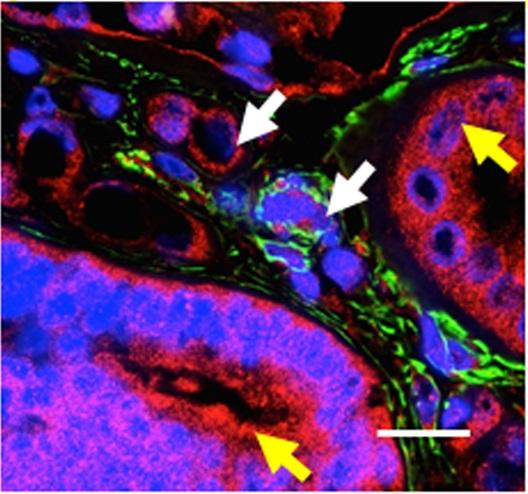A promising target for kidney fibrosis

This is SMOC2 staining (red) in a sample from a patient with kidney fibrosis. Credit: Vishal Vaidya, Brigham and Women's Hospital
Previous studies by investigators at Brigham and Women's Hospital had identified SMOC2 as a protein that was highly upregulated in the kidneys of mice with fibrosis. In a new study published in JCI Insights, investigators report that increasing SMOC2 in the kidney helped initiate and continue the progression of kidney fibrosis, while tamping down SMOC2 prevented it.
To test this, researchers overexpressed SMOC2 in a mouse model of kidney fibrosis and performed RNA sequencing to investigate the mechanisms responsible for fibrotic development. They found that SMOC2 activated a fibroblast-to-myofibroblast transition (FMT).
The team then used two approaches to “silence” SMOC2 – a genetic approach, by using SMOC2 knockout mice, and a pharmacologic approach, by administering SMOC2 siRNA. Using these approaches, researchers were successful in tamping down the protein's production, which protected against fibrosis development.
Corresponding author Vishal Vaidya, PhD, of BWH's Renal Division, notes that one of the exciting things about SMOC2 is that it can be detected in a patient's urine. Now that a functional connection between the protein and kidney fibrosis is becoming clearer, SMOC2 is looking like an increasingly useful biomarker for detecting fibrosis. In addition, SMOC2 may be a promising therapeutic target for an unmet medical need.
“We want to be able to intervene before the tissue becomes severely fibrotic to the point of no return. Our investigation indicates that SMOC2 could be a key to protecting against kidney fibrosis initiation and progression,” said Vaidya.
###
This work was made possible through funding by the Partners Innovation Discovery Grant, Outstanding New Environmental Sciences, Innovation in Regulatory Science Award from Burroughs Wellcome Fund, the Harvard Catalyst, the National Institutes of the Health, the National Institute of Environmental Health Sciences, the Harvard Medical School Laboratory of Excellence in Systems Pharmacology and the Giovanni Armenise-Harvard Foundation.
Media Contact
All latest news from the category: Health and Medicine
This subject area encompasses research and studies in the field of human medicine.
Among the wide-ranging list of topics covered here are anesthesiology, anatomy, surgery, human genetics, hygiene and environmental medicine, internal medicine, neurology, pharmacology, physiology, urology and dental medicine.
Newest articles

Bringing bio-inspired robots to life
Nebraska researcher Eric Markvicka gets NSF CAREER Award to pursue manufacture of novel materials for soft robotics and stretchable electronics. Engineers are increasingly eager to develop robots that mimic the…

Bella moths use poison to attract mates
Scientists are closer to finding out how. Pyrrolizidine alkaloids are as bitter and toxic as they are hard to pronounce. They’re produced by several different types of plants and are…

AI tool creates ‘synthetic’ images of cells
…for enhanced microscopy analysis. Observing individual cells through microscopes can reveal a range of important cell biological phenomena that frequently play a role in human diseases, but the process of…





















